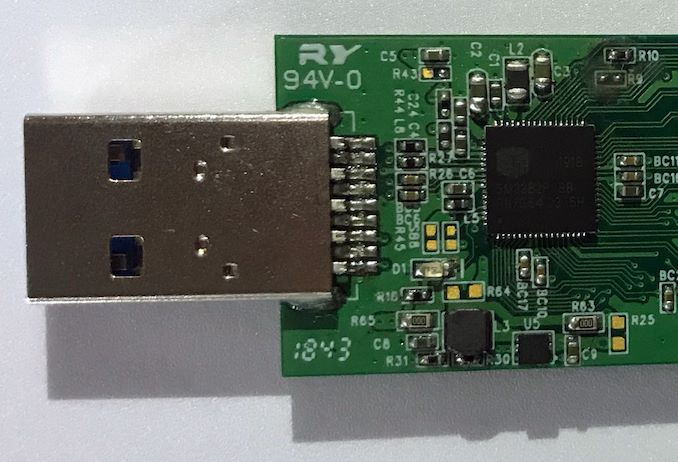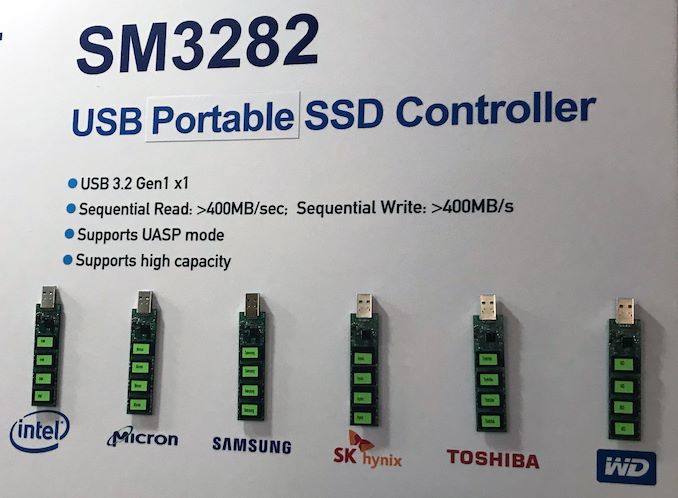A USB Stick as an SSD? A New Silicon Motion SM3282 Single-Chip Controller for USB SSDs
by Anton Shilov on May 31, 2019 3:00 PM EST- Posted in
- SSDs
- Storage
- Silicon Motion
- 3D NAND
- External SSDs
- Computex 2019
- SM3282

Silicon Motion has introduced its first single-chip controller for portable USB SSDs. The SM3282 promises to enable makers of portable drives to offer up to 400 MB/s sequential read speeds in a cost-efficient manner previously unachievable by external SSDs.
Silicon Motion’s SM3282 chip packs a USB 3.0 (aka USB 3.2 Gen 1) controller alongside an SSD controller featuring 2 NAND channels with 4 CE (Chip Enables) per channel, integrated 3.3V/2.5V/1.8V/1.2V voltage regulators, and other necessary things. The chip comes in a 68-pin QFN package and supports the latest types of 3D NAND memory (including 3D TLC and 3D QLC memory featuring up to 96 layers) from all leading suppliers of flash. It also supports both USB Type-A as well as USB Type-C connectors.
Previously, makers of external SSDs had to use a USB-to-PCIe bridge alongside an SSD controller to build their products, which greatly increased BOM costs as well as the final price. The SM3282 packs all the necessary functionality into a single chip and thus reduces BOM cost of external SSDs.
As far as performance is concerned, the SM3282 can enable external SSDs featuring up to 400 MB/s sequential read and write speeds. Meanwhile, producers of actual SSDs tend to use different types of memory with different interface speeds, so performance of actual devices will vary.
This week Silicon Motion is demonstrating prototype external SSDs based on the SM3282 at Computex. Expect commercial drives powered by the controller to be available in the coming quarters at a variety of price bands.
| Want to keep up to date with all of our Computex 2019 Coverage? | ||||||
 Laptops |
 Hardware |
 Chips |
||||
| Follow AnandTech's breaking news here! | ||||||















46 Comments
View All Comments
Valantar - Sunday, June 2, 2019 - link
That's nonsense. The temperature sensors on SSDs are largely embedded into the controller die, as that's the most temperature sensitive part, and the one in need of monitoring (flash doesn't get very hot by itself). In other words, thermal readings from most SSDs are controller die temp readings. Otherwise, how would they throttle to protect themselves?And no, the first generations of NVMe drives didn't break because of heat. Can you show a single source reporting high failure rates of early NVMe drives? You can't, because most of them are still fully functional today. They mostly come with heatsinks today because _it sells better_ (and most of these heatsinks are _terrible_ at cooling). There are still plenty of options without, and most drives from top brands (Samsung, WD, HP) and a bunch of smaller ones are available both with or without a heatsink. The heatsinks are largely ornamental, and only matter if you either have a very poorly cooled case or if your workload is more akin to a server workload - and then only if the heatsink is actually any good.
As for speed: this is an external flash drive design. The use case for such a drive is radically different than an internal SSD, and even those differ in their use cases (is it a boot SSD or a game drive?). And, again, this is largely a replacement for cheaper flash drives but with better performance or a move to bring SATA-ish performance down in price, not something to supersede expensive SATA-to-USB drives in terms of performance - those are being superseded by NVMe-to-USB enclosures anyhow. And again: if you need that much speed or more, an actively cooled DAS is likely better suited to your workload. The aim of this product is clearly to bring mid-high performance to lower price brackets. And again: sure, it's going to get a bit toasty under sustained loads. It will no doubt throttle if it's stuck in a cheapo plastic casing and hammered with writes. But that's just the thing: throttling prevents overheating, which again prevents a lot of early hardware death. This is only an issue if you're looking for something this isn't: a high-performance external SSD for strenuous usage. If that's what you're looking for, this product isn't for you, and in case that wasn't clear, that's not at all a reason for the product not to exist or to be called bad.
Also: you'd do well to try not expressing yourself like an obnoxious and condescending ass. What's the point?
Beaver M. - Sunday, June 2, 2019 - link
I work in that sector, my friend. I said everything I wanted to say. As always some troll comes along and tries to talk stuff he doesnt know anything about. I dont care what you say. I know whats going on. And I also know a lot of manufacturers get more audacious every year. Look for example at the gaming monitors, which are maybe worth $300 at max, have no proper QC, or even QA, yet get sold for $1000 to $2000. So I wouldnt be surprised if someone tries to sell a flawed product again.As I said, not much use trying to talk sense into you. You attacked me first with your implications that I lie. So dont point your finger at me now. Thats a troll tactic.
Valantar - Sunday, June 2, 2019 - link
Implications that you lie? What on earth are you talking about? I _disagreed with you_. If you can't tell the difference or see that as an attack, that's your problem not mine. And if you claim this is a "troll tactic", you're clearly not actually interested in discussing. If so, again, that's your problem, not mine.As for working in "that sector", it's not clear what you mean by that (storage? flash production? something else?), and how on earth would I know? But regardless of that, you seem to have a lacking overview of the current portable storage market. There are plenty of flash drives currently available with speeds in roughly this class, most of them based on SATA-to-USB bridges. You say OEMs tried initially but gave up because of high failure rates; availability of drives like Patriot's Supersonic Rage, SanDisk's CZ880, HyperX's Savage, Corsair's Voyager GTX, and other drives with 300-400MB/s transfer rates shows that this is still a viable product category and has wide availability. Do they get hot? Absolutely! AnandTech's reviews of products in this class has shown quite a lot of throttling. Do they fail prematurely? Well, most flash drives are made cheaply and have poor protection, so one could argue yes, but these are no more likely to fail than any other flash drive - unless you use them in a manner they're not designed to handle. In which case, again, an actively cooled DAS is what you ought to be using.
As for comparing this to gaming monitors (which is a very broad field, and as with anything there are both some good products deserving of premium pricing and some overpriced garbage), that's a bit weird. Flash drives are a commodity - even high-speed ones - while monitors are not. There's a lot of scammy crap in the computer industry, but dismissing what looks to be a decent low-cost, low-power, mid-performance single-chip USB SSD controller - with hitherto unproven performance and heat output - due to whatever bad experiences you have had or read about, that's ... illogical. At best. Nobody is saying this will be the be-all, end-all of flash drives, but there's reason to believe it'll roughly match SATA-to-USB bridge flash drives in performance while running cooler and costing less. Isn't that a good thing? We should of course wait for reviews - as with everything - but your categorical dismissal is out of touch with reality.
Santoval - Saturday, June 1, 2019 - link
What about I/O? And why on Earth strangle it with a USB 3.0 (as was simply -and elegantly- used to be called before USB-IF retroactively -and foolishly- rebranded it to USB 3.1 Gen 1 and now doubled on the branding absurdity by a retroactive rebrand of the retroactive rebrand to USB 3.2 Gen 1...) interface, which is now two generations behind the cutting edge?name99 - Saturday, June 1, 2019 - link
“Strangle it?” Are you serious? 400MB/s on a USB stick isn’t good enough for you? When alternative USB stick technologies may run at ~8MB/s?Christ, kids these days...
Valantar - Saturday, June 1, 2019 - link
Pretty sure this is meant as a low-cost alternative to slower USB flash drives, bringing decent performance down in price, not a replacement for current high-end flash drives.Lord of the Bored - Sunday, June 2, 2019 - link
USB SuperSpeed 5.Valantar - Saturday, June 1, 2019 - link
What strikes me is just how simply that PCB is laid out. Ought to bode well for low-cost, high-capacity drives.lilkwarrior - Saturday, June 1, 2019 - link
Kind of DOA with USB4 converging w/ Thunderbolt 3 and why on earth would most modern PC users would want it in a USB-A form form factor instead of USB-C?Especially considering high-end laptops? They have USB-A for legacy (primarily business) reasons, but it's prone to connectivity breakage & etc that USB-C was made to make obsolete.
Valantar - Sunday, June 2, 2019 - link
The chip has native USB-C support, they likely just made it type-A for the demo as it's a bit easier to implement. As for this being DOA: TB3 is expensive and power-hungry, this is clearly meant to improve the performance of cheap(er) flash drives, not fight for high end performance accolades. Arguably this is more important - we already have fast, expensive TB3 storage, lifting the performance floor has more value at this point than raising the ceiling.